After a longer-than-anticipated hiatus, we continue our play-through of the “Totensonntag” Pint-Sized Campaign for Chain of Command. Previous episodes can be found here:
Part 1: Introduction to “Totensonntag”
Part 2: Let the Battle Begin!
Part 3: A Delaying Action
Part 4: Flank Attack!
Part 5: The Fortunes of War
Part 6: Attack on Brigade HQ
In our previous installment of this series, the German attack on the headquarters of the 5th South African Infantry Brigade was thwarted by the timely arrival of remnants of the British 22nd Armored Brigade’s 3rd County of London Yeomen. The unexpected appearance of British armor disrupted the German advance and Krauss was forced to order his platoon to withdraw and regroup to avoid further losses. But with the British tanks having moved off to the east, orders come down from 8th Panzer regimental HQ to renew the assault!
For this game I was back to playing solo, as my schedule has been a nightmare of late, making coordinating with the usual suspects tricky. But Chain of Command is so good solo, and (spoiler alert) this game was a veritable see-saw that was full of surprises even though I was playing against myself!
The Mission
The last game saw the Germans straight-up lose a scenario for the first time. That means that they did not advance on the campaign ladder, which in turn means that they are attempting the same mission (“Attack on an Objective,” scenario #6 from the main Chain of Command rulebook) again.
As mentioned previously, this mission is something of a ball-buster for the Germans because there’s no shortcut – in order to claim an outright win, the Germans have to reduce the South Africans’ Force Morale to 0. Now that the entire South African force has been upgraded to Regular, the Germans can no longer count on the double-whammy of Enforced Deployment and Green to net easy casualties that result in losses of Force Morale. Indeed, in the last game the South African player only deployed two of the units from his core platoon (a single infantry section and the platoon sergeant). This essentially means that in order to pull out a win, the German tanks now need to throw down against units that have a decent chance of hurting them.
Setup
As before, the tents represent the main scenario objective, the encampment of the 5th Brigade’s HQ. Again there will be 5 burning vehicles on the table at the beginning of the game.
Aside: the campaign allows for the option of placing an additional burning vehicle for each tank destroyed in a previous game if the Germans are forced to re-fight a scenario, but I’m not sure I have enough smoke to represent the carnage from the last game, so I opt not to.
The three objective vehicles this time came up as two ammo carriers and a fuel truck, which is pretty high-stakes for everyone involved. This represents a total of 10 Victory Points up for grabs for the Germans (3 for each of the ammo trucks and 4 for the fuel truck) if all three are captured and 11 Victory Points for the South Africans (4 each for the ammo trucks and 3 for the fuel truck) if everything escapes.
Randomizing the location of everything per the campaign rules led to a situation where the burning wrecks were largely concentrated on the northern side of the field. The one closest to the German baseline was actually snugged up almost all the way along the western board edge. The two ammo trucks were situated on the South Africans’ half of the table, one to the east and one to the west of center. But the fuel truck was situated directly south of board center and relatively close to the German baseline. A tempting target indeed!
The wind direction has shifted since the last battle was fought, now blowing directly from north to south. This aligns the plumes of smoke along the German line of advance, and combined with the placement of the wrecks around the periphery of the board portends that this scenario is going to be a shooting gallery with very little obstruction in the middle of the table (at least until the South African support vehicles start moving or get destroyed).
Choosing Supports
Given the likelihood of facing significant AT assets from the South Africans, I had initially thought to go in full-bore damage mode and just spend points on more tanks with HE capabilities much as I did in Scenarios #2 and #4. But that fuel truck feels agonizingly close, and gives me a lot of pause in my choice of support. The cheapest infantry support choice the Germans can get right now is a 3-man mortar team in a Kubelwagen or on a motorcycle, but even that clocks in at a hefty 8 points (as by this point the panzers have left their supporting infantry in the dust). That’s the equivalent of two Pz II Cs!
As an aside, the German player always has the option to “reset” the costs of their infantry supports by pausing for a full Campaign Turn to let the slower-moving units catch up. No battle is fought, and in exchange the South Africans get a free entrenchment to use in the next battle – the men use the lull in fighting to make hasty fighting positions. And of course we can’t forget the extra point of support they get for each successive elapsed Campaign Turn. But finishing early is also worth Victory Points for the Germans, so it’s a cost-benefit analysis. Given that they were repulsed in the last attempt at this scenario, I feel like it’s now or never. Also, with my luck I’d pause to let the infantry catch up and be confronted with a trio of ambulances in the following turn.
Ultimately, it is the openness in the middle of the table that convinces me; there’s just no way to keep such a small infantry unit in a soft-skinned vehicle safe for long enough to effect a capture (provided I could get a tank to survive out there long enough to get it to surrender in the first place). No, maximum destructiveness is the way to go here.
As such, the Germans are just going to try to blast every South African vehicle off the table. This is a risk, as it’s going to result in fewer German VPs – and if the South Africans do manage to get any support vehicles to safety it will be disastrous. But the plan is to load up on HE, and of course to use the pre-game barrage to (hopefully) give me a few turns of freedom before the heavy guns come out. As always the Germans retain the ability to perform an “Armored Advance,” but that’s not the same as a win. The panzers will concentrate fire on the AT assets, but will try to maneuver up the table such that an “Armored Advance” can be attempted if things go pear-shaped. Thus, my 13 points of available support go to:
- A pre-game barrage (2 points)
- A Pz IV D (5 points)
- A Pz II C (4 points)
- An Adjutant (1 point)
The astute among you will note that this only adds up to 12 points. I struggled with the choice between the 1-point adjutant and the 2-point Red Die, but ultimately I feel like Krauss’ radio is just too valuable and I want him on the table directing the fight rather than in the rear directing traffic. Similarly, they could field two Pz II Cs to get the Red Die, but the little tanks are paper-thin and likely to get blasted. Or field two Pz IV Ds, but they aren’t as fast should the Germans need to make a run for it. As such, the last support point is left unspent (as there’s nothing else worthwhile I can get for just a single point).
Finally, having lost more tanks in the last battle, the Germans use their second and final call for replacements, which adds a tank to the core platoon. This still leaves them one tank short, however, so the margin for error is substantially reduced. Once again turning to the At the Sharp End supplement to give our new tank commander some flavor, we get the following:
Unteroffizier Klaus Wessel: A short, scrappy dockworker in Kiel before the war, Klaus was once a card-carrying member of the Communist party but is smart enough not to talk about that in the current political climate. While at 26 years old he still harbors pro-Communist leanings, his more pressing ambition is to live through this mess long enough to see a brighter future for Germany post-Hitler.
Meanwhile, given that this is Campaign Turn 6, the South Africans have a comfortable 9 points of support to spend. While I am tempted to just go whole-hog and drop a 25-lb gun and two 2-lb guns, I feel like it’s a better bet to actually forego one of the 2-lb guns and invest in a couple of Entrenchments. Because the bedrock was extremely close to the surface (as little as 9-inches down in places) on this battlefield, digging meaningful trenches was largely a non-starter. As a result, the campaign includes a special rule which dictates that entrenchments offer only soft cover (rather than hard cover as they normally would). However, the gun-shields with which the South African AT guns are equipped also provide an additional level of cover, which brings things back up to hard cover. Given the amount of cover-reducing HE likely to be headed their way, this seems like a worthwhile way to reduce the amount of Shock and casualties that are going to get piled on the doughty teams manning the guns. As such, the South Africans’ supports end up being:
- A 25-lb artillery gun with 5 crew and Junior Leader (5 points)
- A 2-lb AT gun with 5 crew and Junior Leader (2 points)
- An entrenchment for a single team (1 point)
- An entrenchment for a single team(1 point)
Force Morale
Given the losses in the last game, the German tank crews are a lot less enthusiastic about the situation than they had been early on. They’ve lost any bonus to Force Morale from the Men’s Opinion. Fortunately, Krauss’ (perhaps unrealistically rosy) outlook still gives them a +1, netting a final Force Morale score of 10. Similarly, things aren’t quite as dire for the South Africans as they had been, but a terrible roll and a continuing -1 penalty sees their Force Morale start at the minimum value of 8.
Patrol Phase
As before the scenario allows the Germans D3+1 free moves, and this time the roll goes in the Germans’ favor, netting the maximum of 4. That is huge, especially given that the Germans are again using only three Patrol Markers.
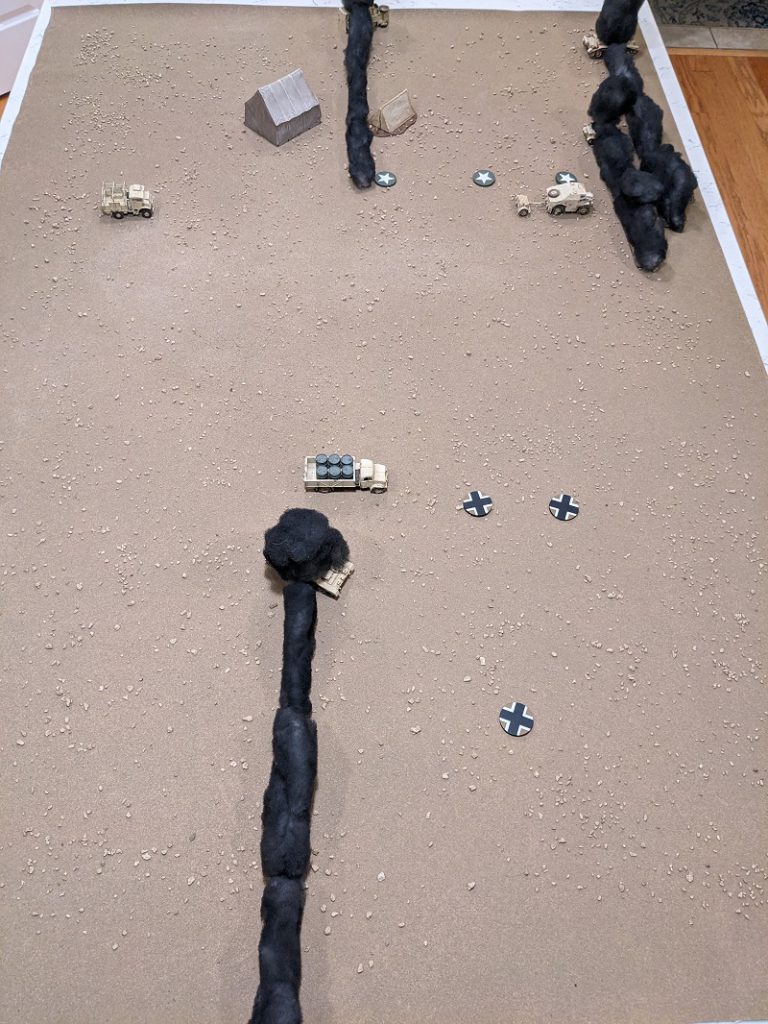
The openness in the middle of the field gives the Germans something of an opportunity here; if they can race up the table quickly enough, they can prevent the South Africans from being able to place JOPs close to the ammo trucks (as these need to be placed at least 6″ back from the patrol markers and in cover), which will in turn prevent them from deploying a Senior Leader nearby to get them moving.
This time I was struck by the competing goals of the South Africans. On the one hand, it was important to anchor the eastern flank, but at the same time I felt like I couldn’t over-commit to it without exposing myself to allowing the Germans to advance a JOP up the western board edge. This was a trade-off between protecting the objective vehicles or giving the Germans an easier run at making an Armored Advance. In the end, the objective vehicles trumped my concerns about opening up my western flank and I started the Patrol Phase with the eastern-most marker hugged right up against the table edge, with the next nearby enough to “pinch” any German attempt to advance enough to cut off the fleeing vehicles.

However with only three markers, the Germans are able to lock quickly, which prevented the South Africans from being able to fully pinch off the eastern flank. The Germans were still able to get a JOP about a foot along that table edge. But when placing the South African JOPs, I was suddenly aware of how narrow the firing lanes were – the center of the table was open, but the presence of smoke, tents, and vehicles really made things tighter than I anticipated. Worse, one of the South African markers was in a weird spot and didn’t really offer a lot of options for good placement. I ended up putting a JOP way back at the northern edge of the table. The saving grace was the “free” JOP that the defender is allowed to place at the objective itself in this scenario, with a deployment point once again hiding in the main headquarters tent.
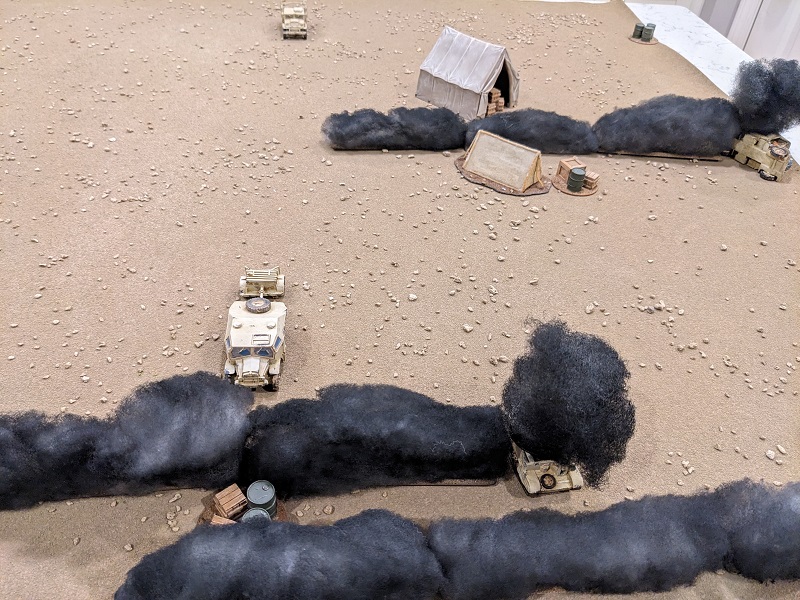
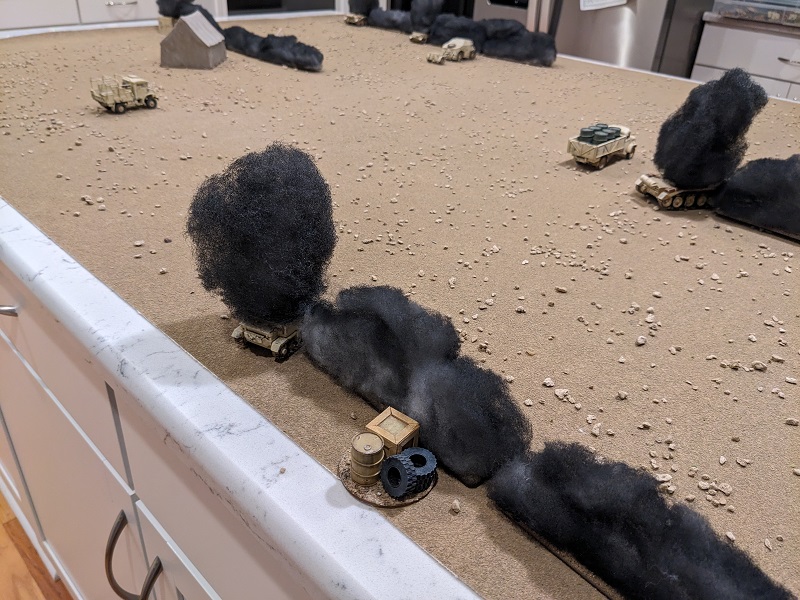
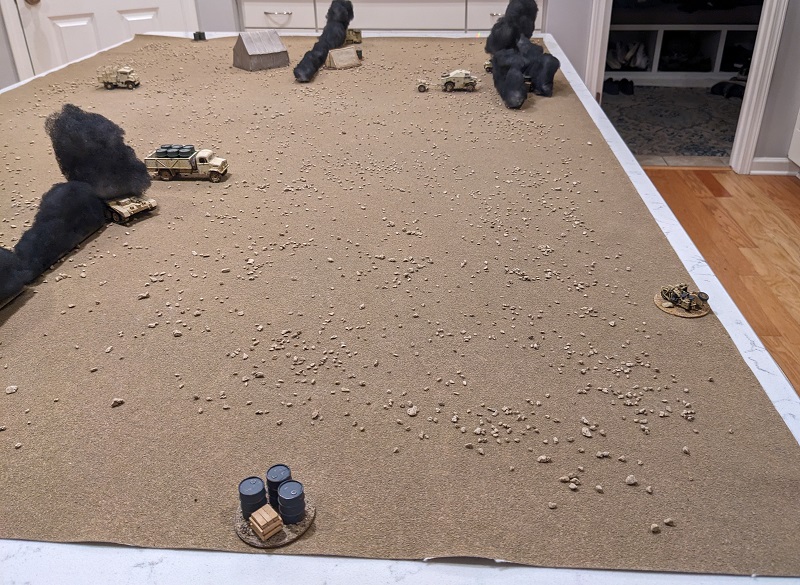
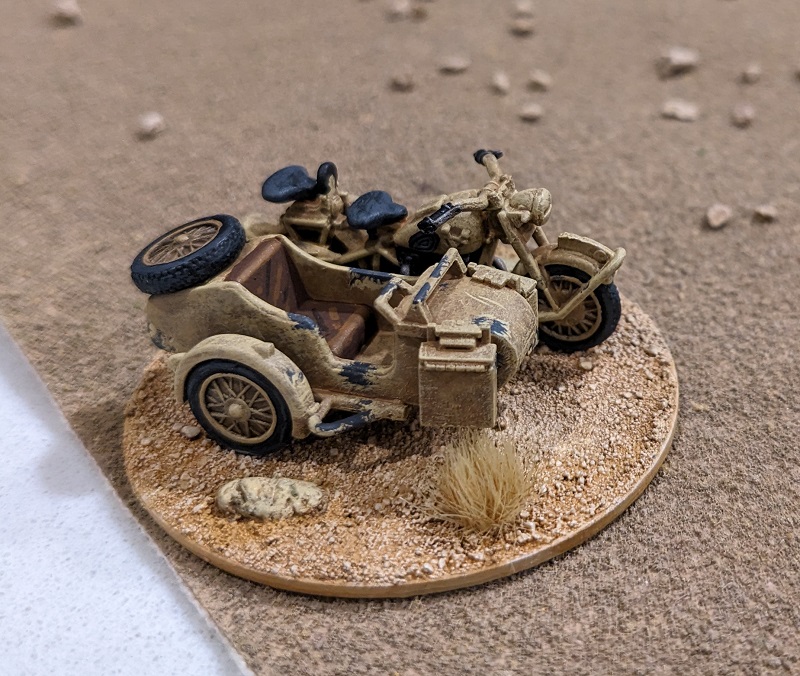
The Battle
As before, the attacker takes the first phase in this scenario. That means the Germans will be starting off again.
Turn 1, Phase 1 (German): 64422 – The Germans seem destined to have crap opening rolls in this campaign, and this one was no exception. The only tank I could bring on here was Krauss’ command tank, which (generally speaking) is a terrible idea. My initial instinct was to just pass and cede initiative to the South Africans, but then I noticed that the westernmost ammo truck was both close enough to an allied JOP to allow a leader to deploy and immediately activate it, and close enough to the table edge that a single activation would probably result in its escape. If the South Africans were still operating under Enforced Deployment I might have risked it, but by this point the entire South African force is rated as regular. No, the Germans needed to act fast to keep that vehicle (and its 4 campaign Victory Points) from escaping.
So I deployed Krauss, who immediately ordered his gunner to light up the vehicle. From here the shot was in the open and the vehicle was still stationary, so he only needed a 5 on 2D6 to hit. Perhaps shaking off his earlier gunnery woes the round struck home and detonated (barely, I rolled a 5!), destroying the vehicle. More smoke flooded the battlefield. The hull gunner was placed on overwatch and play passed to the South Africans.

Turn 1, Phase 2 (South African): 33222 – Wow, that was a great roll! The 25-lb gun easily passed the roll to deploy through the opening barrage (along with its associated entrenchment), setting up next to the HQ tent and sighting straight over the barrel at Krauss’ command tank (which suddenly felt very exposed!). Needing only a 5 on 2D6 to hit, imagine my chagrin when the dice came up a 4. So close! On the plus side, the overwatch machinegun fire from the German tank was similarly ineffective. Just to maximize the chances of activating in future phases, the South African Platoon Sergeant also deployed with the 25-lb gun team, making a mockery of the German pre-game barrage.
Staff Sergeant Thomas Blick of the Transvaal Horse Artillery coolly assessed the work of the men of his gun crew and found it wanting. No, this would never do. “Remember your training, lads. Keep your heads, reload, and let’s try that again.”
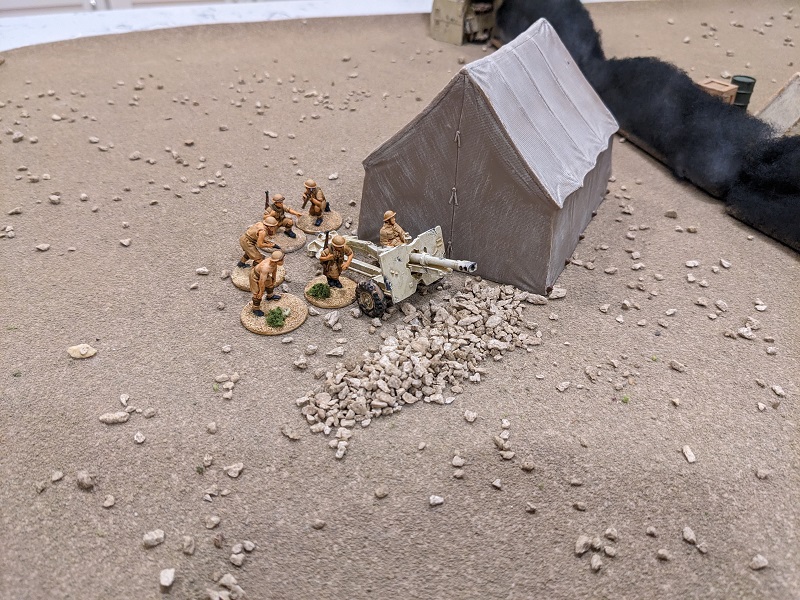
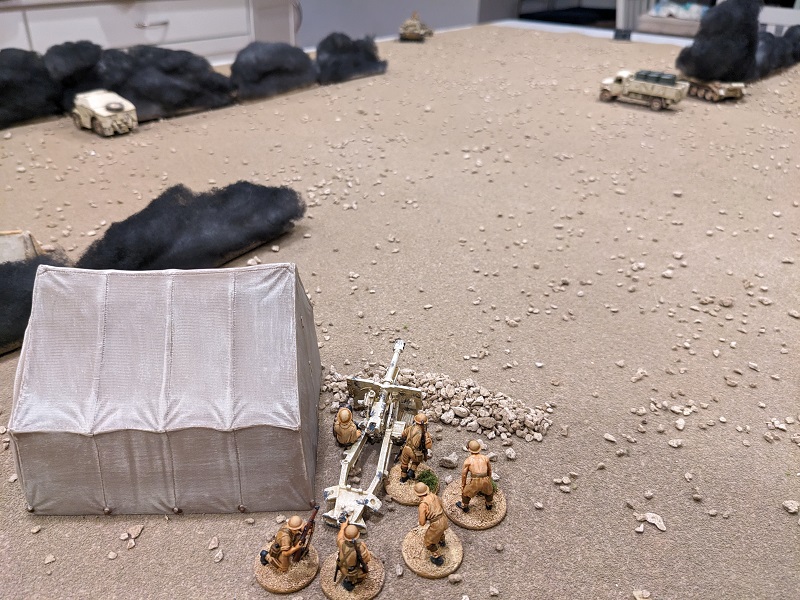
I considered also deploying the 2-lb AT gun, but given the location of the smoke I really didn’t have anywhere to put it to get a clean shot on the German Leutnant’s tank. Best to keep the South Africans’ powder dry and wait for a better target (or maybe a double phase).
Turn 1, Phase 3 (German): 54331 – Now that’s more like it! Krauss activated immediately, ordering his gunner to send a 50mm HE shell at the South African artillery piece that had just revealed itself. The shot struck true, killing one man and inflicting a point of Shock. He then ordered his driver to advance, which put some smoke between him and the enemy gun. The Pz IV D then deployed, opening up with both its larger 75mm HE and hull-mounted MG-34 to inflict another point of Shock.
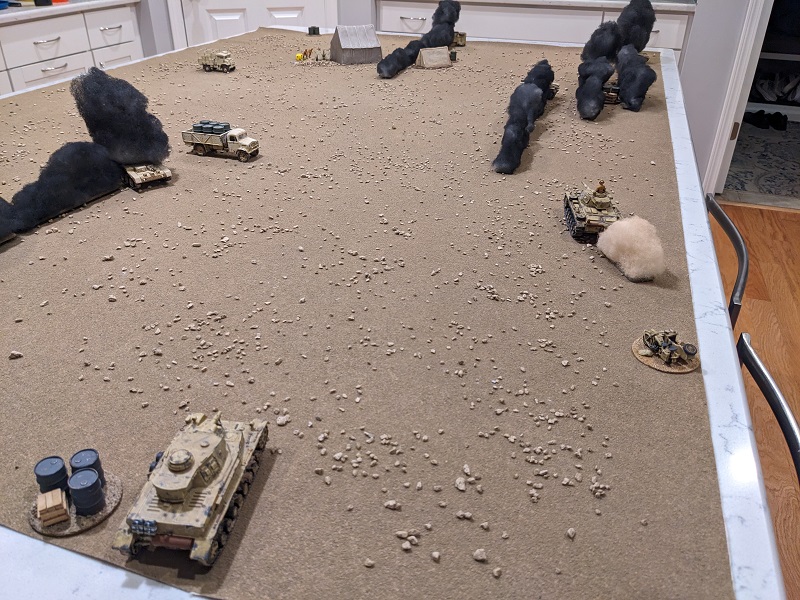
Finally, the little Pz IIC deployed and was just able to see the gun and crew around the smoking wreck of a vehicle destroyed earlier in the battle. The 20mm autocannon barked, inflicting a kill and two Shock. The coaxial MG added to this fire, inflicting another whopping 3 Shock. Even with the hasty sangar erected for protection, the gun team now had 7 Shock and only 5 men (including the two leaders). In just a single phase of enemy fire they were pinned!
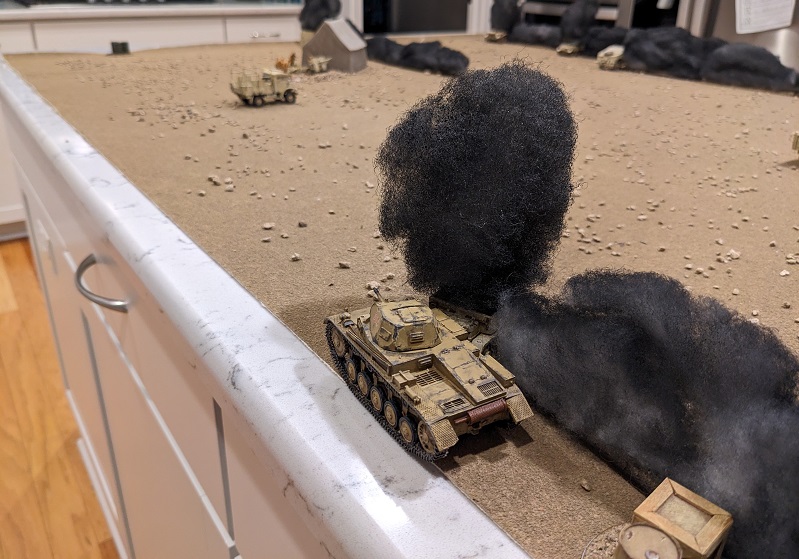
Turn 1, Phase 4 (South African): 43211 – With the field now a target-rich environment, the South Africans successfully brought on their 2-lb AT gun through the barrage and opened up on the exposed Pz IV D. The solid round penetrated the tank’s armor, causing it to take 2 Shock and reverse off the table. Meanwhile, the Platoon Sergeant set about rallying the rattled men of the 25-lb gun crew, removing 3 Shock. Staff Sergeant Blick, the gun crew chief, did likewise, pulling off a point of Shock and getting the gun firing at the newly-appeared Panzer IV D. Sadly, this round was also a miss. Finally, the Boys AT rifle team deployed from the JOP on the extreme northern edge of the table and took a shot at the Pz IIC, and while the round hit, the heavy caliber bullet bounced of the tank’s front glacis plate. The only deployment the German barrage was able to prevent was that of the 2″ mortar team.
The storm of fire that erupted around Blick and his crew was terrifying to behold. Already several of the men had been struck dead and he could sense the rising panic. Perhaps left behind when men of his own infantry unit had evacuated, Sergeant Cameron of the 2nd Transvaal (Scottish) regiment was there to lend a hand, checking on the wounded and giving a gimlet stare to any man who might have thought about running. Blick worked hard to bring his gun into action once more, but with Private Jeffries’ visible shaking causing the man to fumble getting the shell seated in the breach, the whole process was taking longer than it should have. And in this hellstorm, Blick suspected that every second was going to count.
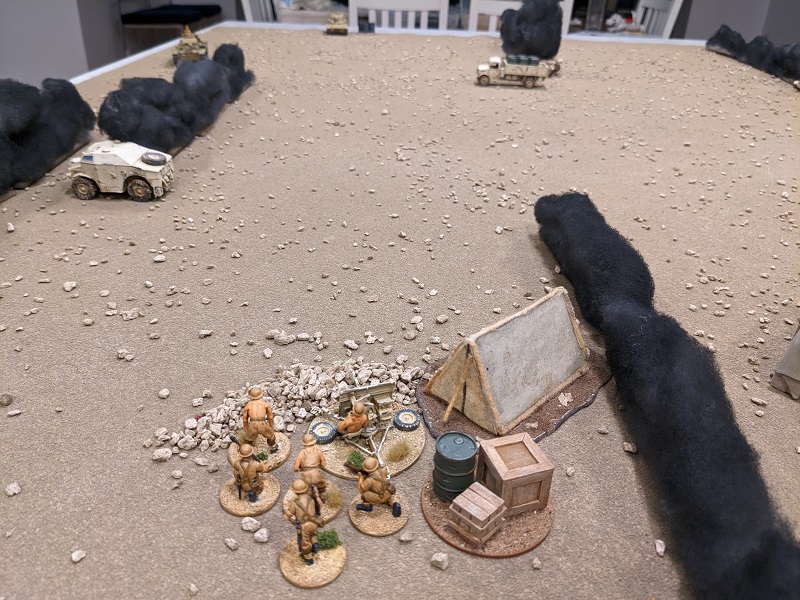

Turn 1, Phase 5 (German): 64433 – Via radio, Krauss commanded the Pz II C to engage the 25-lb gun once more with its 20mm autocannon, tacking 2 Shock back onto that team. Not wanting to leave anything to chance, Krauss then ordered his gunner to direct another 50mm round into the second ammo truck, which exploded in a massive ball of fire. His driver continued to advance north, now well-screened from the South African AT assets by plumes of smoke. Recovering their wits, the Pz IV D rumbled back onto the table, its commander removing a point of Shock and directing more HE at the enemy 25-lb gun. The shot was a little low, but the shower of dirt over the South Africans added another Shock. Finally, Dieter Bauer’s tank deployed. It too opened up on the enemy artillery piece with both its main cannon and hull MG, all to no effect. Turns out maybe that sangar was doing some good after all!
The detonation of the truck carrying much of the battery’s ammunition came as an unwelcome surprise to Blick and his men. Though a few bits of shrapnel rained down on their position, the truck had been parked at a safe distance from the gun itself. Still, the concussive wave momentarily sucked the air from his lungs. But now they were limited to just the ammunition in the nearby limber. Once those rounds were expended, they would have no choice but to surrender. Blick did not relish the thought of spending the rest of the war in a POW camp.
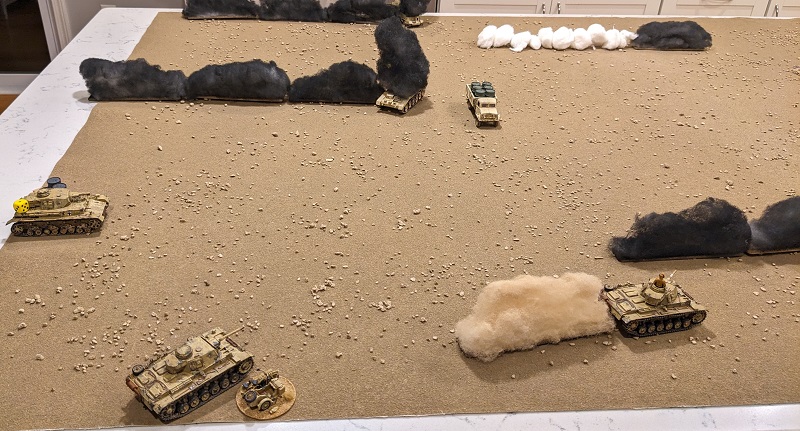
Turn 1, Phase 6 (South African): 55322 – This is the sort of roll that was exactly why I put the Platoon Sergeant with the 25-lb gun, as it would let that him rally off 2 Shock and get that gun to fire while still letting me use the 3 to shoot with the 2-lb AT gun (both at the Pz IV D). Sadly, the 25-lb gun missed again – clearly the crew were feeling the effects of being pinned – and the 2-lb gun’s shot failed to penetrate the heavy tank’s armor.
Turn 1, Phase 7 (German): 65553 – This left very little in the way of activation potential, but did give the Germans a whopping 4 points to build their first complete Chain of Command die. The Pz IV D slowly advanced towards the enemy fuel truck – its driver apparently unable to get the engine started – and lit off another 75mm shell at the enemy artillery, though to no effect at all.
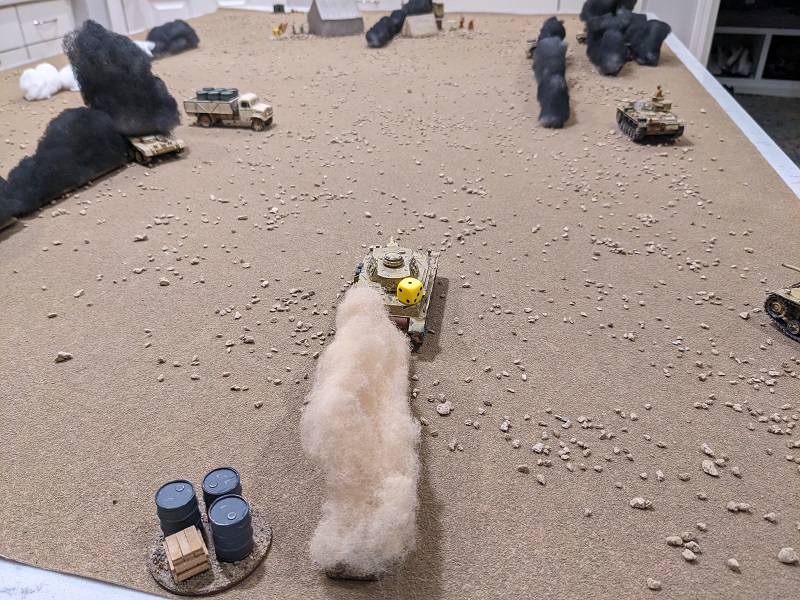
Turn 1, Phase 8 (South African): 54433 – With all of their AT assets now deployed, the South African Lieutenant tried to deploy but was confounded by the German barrage. The Platoon Sergeant again rallied 3 Shock off the gun crew and both guns opened up on the Pz IV D. Just like last phase, the 25-lb gun missed and the 2-lb gun hit but had no effect.
For as much solid-core shot and high explosives were flying around the battlefield right now, both sides were hanging tough! Blick tried to exhort his men to move faster, but every time a man moved away from the (relative) safety of the gun shield to the nearby limber, machinegun fire forced them back. At this rate, they’d be lucky to get another shot off before being overrun.

Turn 1, Phase 9 (German): 66321 – A double phase! Krauss was quick to have both the Pz IV D and Bauer’s tank send more HE at the beleaguered 25-lb crew, but for all that this fire only inflicted another 2 Shock on the men. It appeared that the destruction wrought on these men in the opening phases were a fluke. Krauss’ last CI was spent activating the Pz II C’s driver. With its line-of-fire now obstructed by the conflagration that had been an ammo truck just moments before, the little tank raced 11″ forward.

Turn 1, Phase 10 (German) 3222 – The commander of the Pz IV D pulled the last of the Shock off his crew and ordered the 75mm cannon to blast at the 25-lb gun again, still only inflicting a point of Shock. Krauss was once again busy working his radio, ordering Dieter Bauer’s tank to fire HE and activating the hull MG of the Pz IV D to fire. Combined, these added one kill and 1 Shock to that crew. His last order was spent directing the Pz II C’s 20mm to brass up the Boys AT Rifle team, under the theory that these men were in the open and such a small team would be an easy target. Sadly, all shots send in their direction missed.

Turn 1, Phase 11 (South African): 65521 – Ugh, with almost no activation resources, I struggled with the decision here. The 25-lb gun was both pinned and carrying a bunch of Shock, which would make scoring a hit difficult even on a tank in the open. The 2-lb AT gun had a much better chance to hit, but less chance of penetrating armor. In the end I opted for the 2-lb gun, which hit but scored only 0-net successes on the penetration test and ultimately had no effect on the Pz IV D. Curses!
Turn 1, Phase 12 (German): 32221 – This was about as good a roll as the Germans could have hoped for, as it let them activate everything currently on the field. The Pz II C advanced at normal speed (still covering 11″), which brought the Boys team into close range of the 20mm autocannon. This fire was once again inaccurate, causing only a single point of Shock (though without a leader of any kind close, there was no real way to remove it). The Pz IV D again coughed 75mm HE at the enemy artillery crew and again inflicted a point of Shock. Krauss then ordered that tank to slowly advance – it’s important to keep moving as it gets easier to hit a stationary vehicle that you’ve already hit once before. Krauss also directed Bauer to fire more HE, but the round sailed high. Finally, he ordered his own driver to advance, powering 12″ northwards. The thinking here was that the eastern edge of the board was well-screened by smoke. That would allow Krauss to sneak up almost all the way to the table edge and make a dash to perform and “Armored Advance” if things went wrong.

Turn 1, Phase 13 (South African): 55311 – Ooof, again not much to do here. The Platoon Sergeant rallied off 2 Shock and ordered the 25-lb gun to fire, but it again missed. Perhaps the heat shimmer was causing the man laying the gun to misjudge the distance in his panicked haste? The Boys team again fired at the Pz II C, and again they hit but failed to have any effect on the German light tank. But this did give the South Africans their first complete CoC die, which they used immediately in the subsequent German phase.
Turn 1, Phase 14 (German): 54221 – The phase started with a South African Interrupt, in which the 2-lb AT gun again hit but failed to have any effect on the Pz IV D. Argh, an opportunity wasted! Krauss once again ordered both Bauer and the Pz IV D to shower the 25-lb gun crew with HE, the combined effect of which was another kill and 2 Shock. He continued to have his own driver advance flat out, moving another 10″ north. Finally, past the smoke of the burning ammo truck, the Pz II C once again directed both its 20mm and co-axial MG at the 25-lb crew. This fire proved devastating, killing the last two enlisted men and inflicting 3 points of Shock.
And this was almost the worst result they could have gotten, because while all of the men were dead, the gun crew’s Junior Leader was still alive. And one of the rules of Chain of Command is that leaders are made of sterner stuff and don’t carry any Shock. Had there been a single ordinary crewman left alive, the Shock on the group would have been sufficient to see them break (and take both Staff Sergeant Blick and the Platoon Sergeant with them). But as that last crewman went down, Thomas Blick resolved himself right then and there to sell his own life dearly, servicing the gun by himself if need be. Still, with the loss of the men of that gun team, the South African Force Morale dropped to 6.
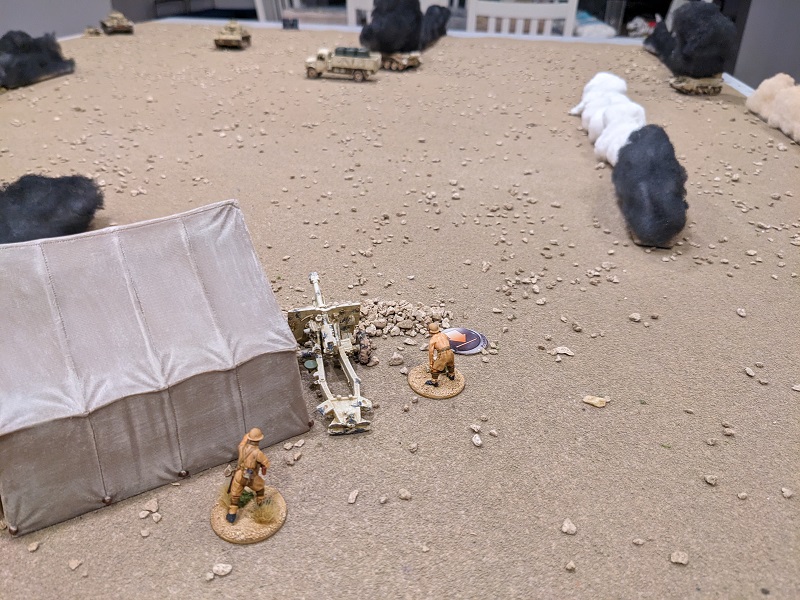
Turn 1, Phase 15 (South African): 64331 – Here the Germans used their own CoC die to perform an interrupt. Hoping to capitalize on the previous success, the 20mm autocannon once again barked at the 25-lb crew. This time the Platoon Sergeant was hit and knocked unconscious, causing the South African Force Morale to drop a further 2 points to 4. This would cause them to lose a Command Die going forward, but since they had already rolled for this phase, the got to keep and use all five. The Boys team again shot the Pz II C but the round bounced. The 25-lb gun again drew a bead on the Pz IV D but again missed (though he ignored Shock, the lone gun-crew chief was still Pinned). But whereas everyone else was failing in epic fashion, the 2-lb gun managed a direct hit on the Pz IV D’s turret. This time the round did not bounce harmlessly aside, instead lodging itself in the 75mm gun carriage and knocking out the heavy German tank’s main armament. This caused the first drop in German Force Morale, which fell to a 9. But more importantly, it removed one of the biggest sources of cover-reducing HE that the Germans were able to throw at the South African gun crews.
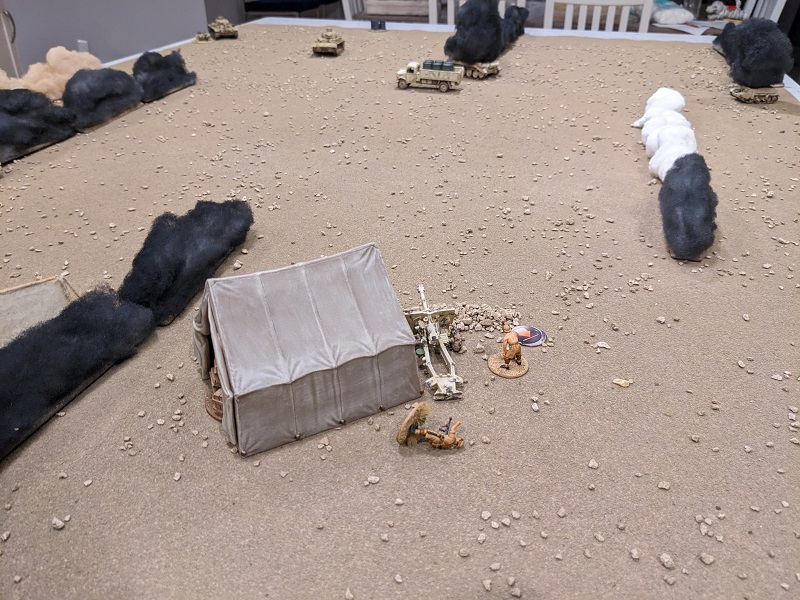
Turn 1, Phase 16 (German): 53111 – Via radio Krauss ordered the Pz II C and Bauer’s tank to send a combined 10 dice of HE at the 25-lb gun, but as the only-leader crew ignored Shock this fire was completely ineffective. The last CI was spent on a desperate attempt, using the co-axial MG-34 from the Pz IV D. Against the odds, this fusillade hit the Junior Leader now manning the gun solo, wounding him and reducing him to just a single CI. This saw the South African Force Morale drop to 3.

Turn 1, Phase 17 (South African): 654 – Ooof. Braving the barrage, the South African Lieutenant arrived on the scene and “gently persuaded” the wounded Blick to keep his gun in action – I’m kidding, there was almost certainly profanity involved, but the effect was successful. Freed of Shock and suffering only the penalty for being Pinned, Blick sent a 25-lb shell screaming down-range and right into Dieter Bauer’s tank, of which there was an unobstructed line-of-sight. Scoring a whopping 8 penetration successes, the Pz III’s armor of 4 could not prevent destruction. Still, it got 3 successes. Miraculously lucky for the Germans, the tank did not explode and Bauer and several of his crew were able to extricate themselves. Still, the German Force Morale dropped 2 points to a 7.
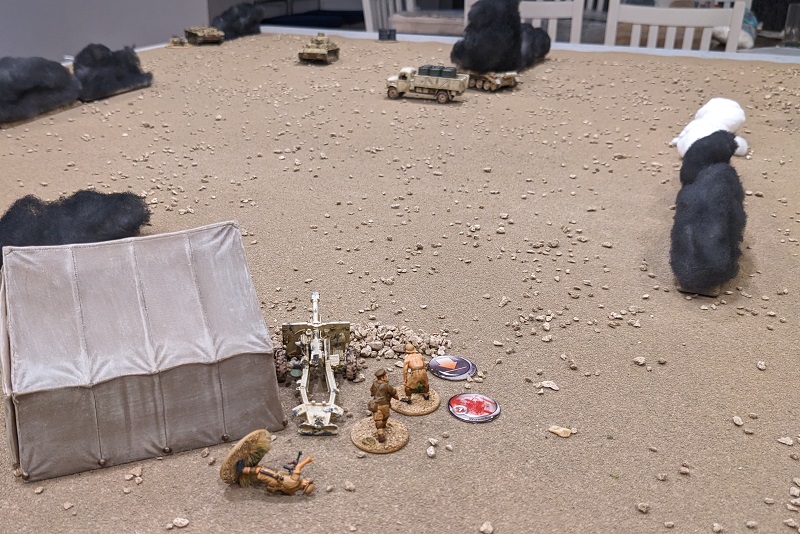
Before he’d been fatally hit, Private Jeffries’ last action had been to load another round into the big gun’s breach. With the nattering lieutenant’s cursing ringing in his ears, Blick pulled the lever to slam it home. Sparing the briefest look over the top of the artillery piece’s barrel and ensuring that it was more or less pointed at a German tank, he yanked the lanyard. At first he thought that the round had missed, as nothing happened. After what seemed like an eternity, smoke began to rise from the vehicle and men began tumbling out.
Unteroffizier Dieter Bauer had thought the enemy artillery piece had been suppressed, as he had not seen anyone moving near it for several moments. Then a muzzle flash, a burst of dust, and a split second later a tremendous CLANG! The heavy-caliber anti-tank round had struck the turret just above the ring, penetrating all the way through the vehicle. And his loader. Worse, spalling from the inside of the turret had turned the interior of the tank into a flurry of sharp shards of metal ricocheting throughout. As the Pz III lacked any kind of turret basket, there was nothing to prevent injury to any member of the crew. Bauer himself was bleeding from his ears as well as a dozen other cuts. With the smell of smoke becoming stronger, his men didn’t need any exhortation from him to begin throwing themselves out the nearest hatch.
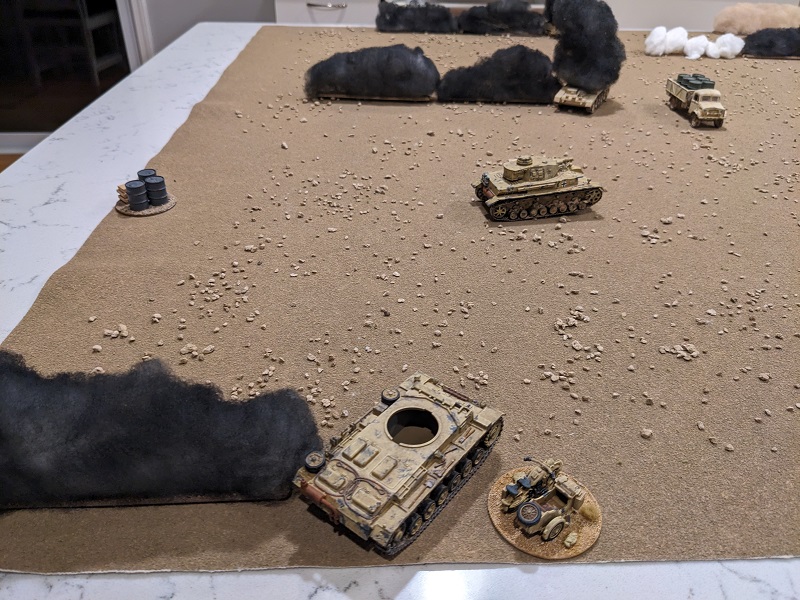
This certainly changed things for the Germans. If that 25-lb gun was given free reign, it could wreak havoc. Wearing my German hat I had held out hope that it could be suppressed or taken out of action, but getting hits on leaders is tough – you have to inflict kills to have any effect whatsoever on them because they don’t care about Shock. So my thinking was to position things such that the Germans could pull off an Armored Advance at a moment’s notice. Essentially, I was almost willing to cut my losses at this point.
Turn 1, Phase 18 (German): 54222 – With this roll only allowing Krauss to activate, this phase was once again all about the radio. One CI went to the Pz II C, which once again sent a stream of 20mm shells at the 25-lb gun. A hit was scored, but it was on the already-unconscious Sergeant Cameron and would have knocked him unconscious again, so it was ignored. The Pz IV D was ordered to advance, rumbling 9″ forward and getting close enough to force the surrender of the fuel truck, which hadn’t moved all game. Try as he might the driver still hadn’t gotten the vehicle started! But more importantly, the Pz IV D could now claim to be partially obscured behind the fuel truck, at least from the line-of-fire of the deadly 25-lb artillery gun. Finally, the German Leutnant ordered his own driver to step on it. The command tank surged forward 12″, putting it perilously close to the northern board edge should an Armored Advance be called for.

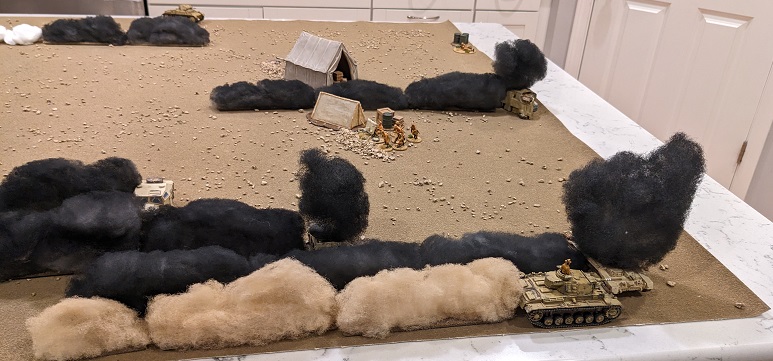
Turn 1, Phase 19 (South African): 654 – Same roll as last time. This time, Lieutenant Dijkstra ordered Blick to fire at the Pz IV D again, but the shot was a miss. He then spent a CI on movement and raced to within his Command Radius of the 2-lb AT gun, spending his last activation on that crew to get the men to re-orient the gun to face east, where Krauss’ command tank lurked just on the other side of a plume of smoke.
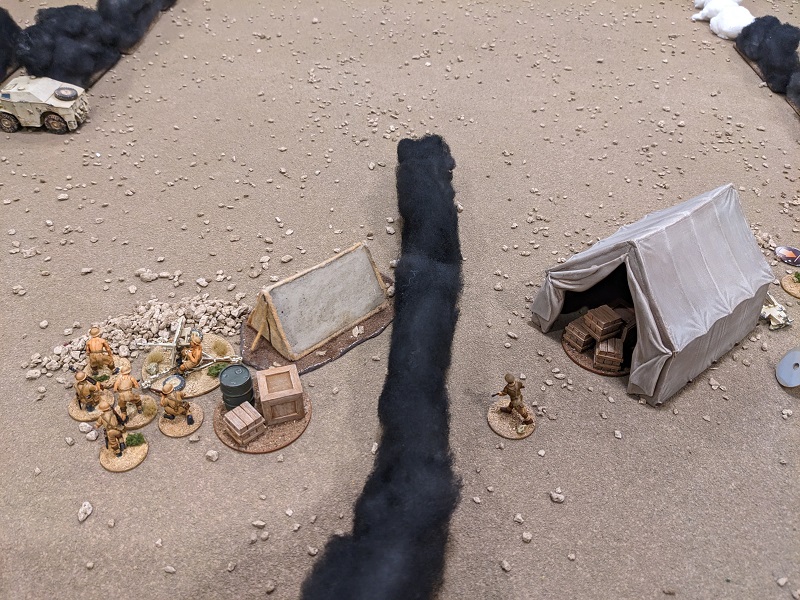
Turn 1, Phase 20 (German): 62222 – Again only Krauss could activate, and again his radio was a god-send. He ordered both the 20mm autocannon of the Pz II C and the co-axial machinegun of the Pz IV D to continue pouring fire at Blick, still manning his artillery gun solo. Miraculously, all this fire had no effect, and Blick continued to service the piece undeterred by the hot lead flying all around him. Truly the man lived a charmed life. I strongly considered using Krauss’ final CI to just have him race off the board and end the scenario, but the South Africans were teetering. And if I could win the scenario, then Bauer’s tank could actually be repaired in time for the next one. I decided to risk it, but didn’t want to give that 2-lb AT gun a shot at the side armor of the command tank, so the last CI was spent ordering the tank’s driver to pivot in place and present the front armor to the enemy gun.
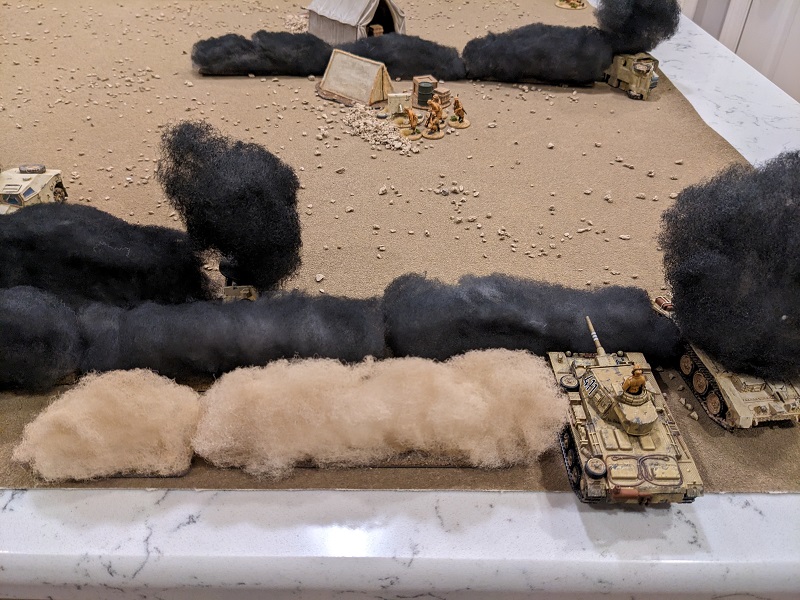
Turn 1, Phase 21 (South African): 421 – The 25-lb gun once again missed the Pz IV D, Blick was clearly trying to do too much at once and rushing the sighting process in an effort to get rounds down-range quickly. The presence of a friendly vehicle in his line-of-fire certainly didn’t help. Lieutenant Dijkstra got the 2-lb gun firing again. Even though the command tank was just an indistinct shadow through the thick smoke, the round struck true! The resulting armor penetration contest saw 2-net hits and a result of 2 Shock and immobilization of the tank! Immobilization of an AFV is another “Bad Thing,” and the German Force Morale dropped by one more point to 6.
Unable to see well through the smoke before his vision blocks, Krauss’ first inkling that his tank had been hit was when the vehicle was violently rocked backwards. Suddenly everyone in the tank was shouting; the gunner saying he had no targets, the loader cursing loudly and picking himself up off the floor. Worse, the driver was hammering at his controls to no effect other than a loud grinding noise. His yells were the most chilling: “Wir können nicht fahren, wir können nicht fahren!!!”

This absolutely changed things for the Germans. While I was still confident that I could probably race the speedy little Pz II C off the table and perform an Armored Advance, that would mean leaving behind both Dieter Bauer’s and Krauss’ tanks. This in turn would drop the German core platoon to just two operational tanks and necessitate a change in platoon leadership. At this stage of the campaign, that could be disastrous! So whereas before the Germans were hoping for a full win, now they absolutely needed one. All of a sudden, this was a fight to the bitter end. And of course Krauss needed to keep from getting blown up in the process!
Turn 1, Phase 22 (German): 65421 – Shouting down the panic rising among his crew, Krauss got his tank in some semblance of a functioning command once more. He methodically worked his loader and gunner through the process of firing, but given the smoke could not be sure if the high-explosive shell had had any effect (it hadn’t). Meanwhile, the Pz II C’s advance had taken it out of the arc-of-fire of the deadly enemy artillery piece – it was safe for the moment – so its commander switched his fire to target the Boys AT rifle team. This fire proved accurate and both men were killed outright. The South African Force Morale dropped a further point to 2, now on the precipice of collapse!
Turn 1, Phase 23 (South African): 331 – Once again the 25-lb targeted the Pz IV D and the 2-lb targeted Krauss’ command tank. Sadly, both missed, but there was very much a sense that any given roll could see a major set-back for the Germans.
Turn 1, Phase 24 (German): 53332 – For the Germans, the highest priority was silencing that 25-lb gun. This roll would let them activate three tanks; calling up his reserves, Krauss brought up both Gehrhart and Wessel’s Pz IIIs (which the purchase of an Adjutant support choice let him do without a roll). Both of these freshly-deployed tanks and the Pz II C fired everything they could at Blick. Never has one man attracted so much fire, and all to so little effect. All told, this was 14 dice of HE and 18 dice of MG fire. It would have inflicted a fairly furious amount of Shock, and had Blick been an ordinary man he’d have retired to the rear in haste. But Blick was an extraordinary man, and all these dice didn’t generate a single 6 (needed for a kill) on the effect dice. So Blick lived to fire again next phase. Unbelievable!
Turn 1, Phase 25 (South African): 543 – Blick returned the favor, sending a large-caliber round at Gehrhart’s newly-arrived Panzer. The round hit, and while it penetrated the tank’s armor the effect was not overly serious. Still, it was enough to cause the driver to throw the tank in reverse and back off the table! And the 2-lb AT gun once again missed Krauss due to the obscuring plume of smoke between them.
Turn 1, Phase 26 (German): 44211 – The Pz II C advanced, moving a further 10″ and bringing it firmly to the rear of the sangared position of the enemy 25-lb gun. From this direction the emplaced gun really had no cover – nor did its gun shield provide any real protection – and at long last the 20mm autocannon finished the job. Blick was hit again and this time did not shrug it off so easily. His wound saw him lose another CI, but since that brought him to 0 the end result was a kill. Finally, the murderous enemy artillery had been silenced, and with it the enemy Force Morale dropped to a 1. For his part, Krauss ordered his own hull MG and main gun to unload on the 2-lb AT gun, but the intervening smoke again resulted in this fire having no effect. His last CI was spent ordering Wessel to advance his Panzer flat out, and it duly raced a hefty 20″ up the table.

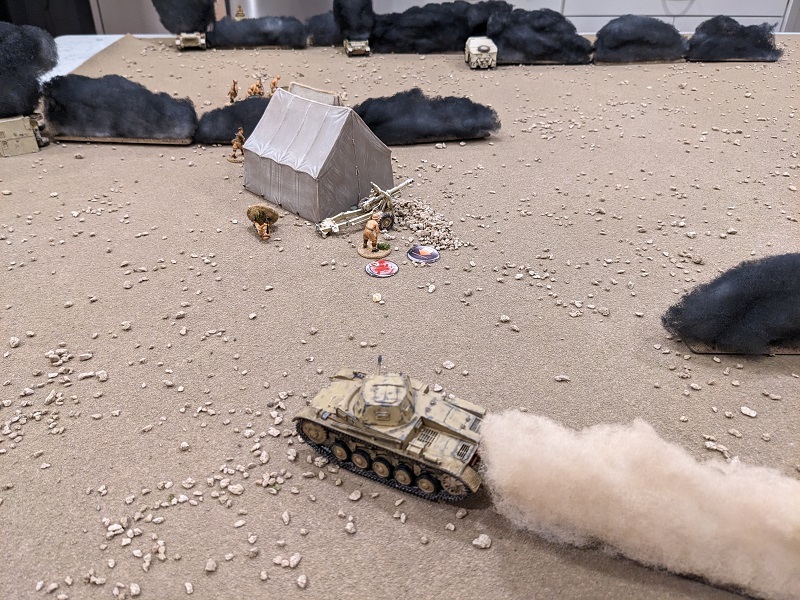
At this point, the Germans just needed to knock a single point off the South Africans’ Force Morale to win, but engaging with the sangared 2-lb AT gun was risky. A better strategy was to capture an enemy JOP and end the Turn, as that is a minimum of -1 to Force Morale. Krauss had driven right past a South African JOP on his way up the board, but hadn’t contacted it (required for it to count as “captured”). And since he was now immobilized, that meant that Wessel was going to have to do it.
Turn 1, Phase 27 (South African): 53 – And as soon as a plan was formed, it went slightly out the window – this roll saw the South Africans build up another complete Chain of Command die. One of the uses to which this resource can be spent is to avoid having to make a Force Morale roll! So now the Germans didn’t need to capture one enemy JOP to end the game, they needed to capture two of them!
Worse, the 2-lb gun fired again and this time it hit. The armor penetration roll was a whopping 4 successes! 3 successes is enough to destroy a tank, so Krauss’ armor saves needed to be decent. Rolling 4 dice (looking for 5s and 6s), the German Leutnant’s battered tank had an equally miraculous armor save, with all four dice coming up successes! The resulting roll on the 0-net hit chart yielded a “no effect” result. Again there was the palpable sense that the Germans needed to finish this shit right now or things were going to go very, very badly.
Turn 1, Phase 28 (German): 54441 – Once again it was all about the radio! Krauss ordered his own gunner to send more HE at the enemy AT gun, but once again the fire was ineffective due to the obscuration. His other two orders were given to Wessel and the Pz II C, commanding both to race for the nearest enemy JOP. Wessel’s tank made contact, but the light tank rolled badly and was just a touch short of the goal.
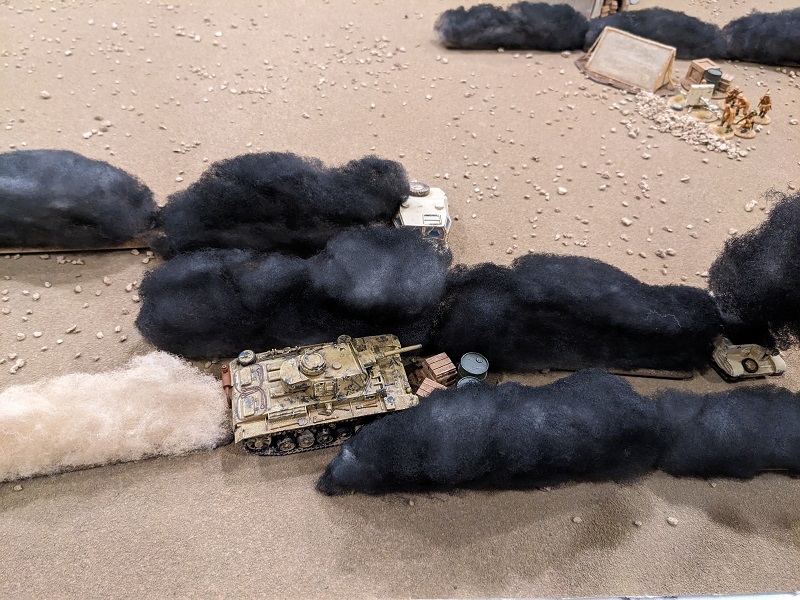
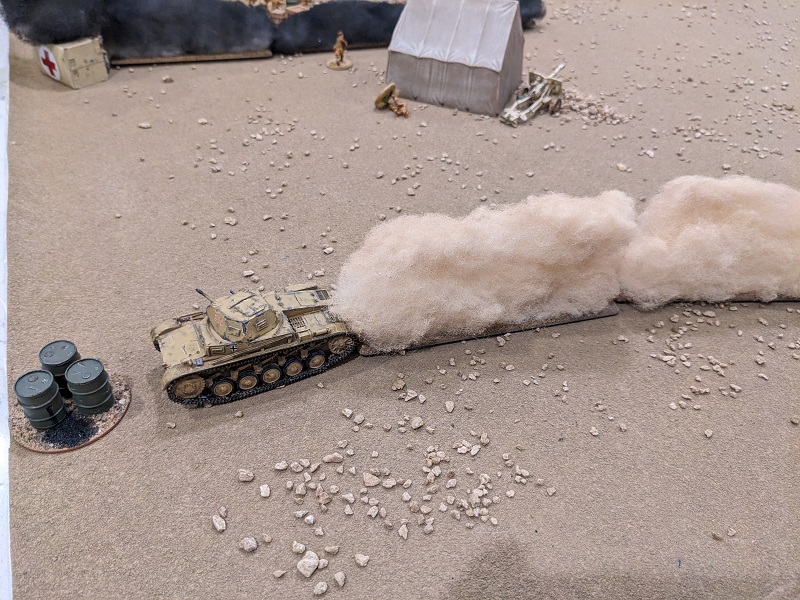
Turn 1, Phase 29 (South African): 23 – It felt like it all came down to this. Having hit Krauss’ stationary tank repeatedly and with the gun-crew chief able to direct its fire, the roll only needed to be like a 6 on 2D6 to hit even with the heavy obscuration of the smoke. Sadly, the roll was a 4, a complete miss.
Turn 1, Phase 30 (German): 65441 – This was enough for Krauss to command the Pz II C to advance the short remaining distance to the South African JOP on the northern board edge and by this point the Germans had enough resources to be able to end the turn. This would necessitate “Bad Things Happen” rolls for losing both JOPs to the enemy, but the Chain of Command die would only let them ignore one of these.
But wait! If the South Africans couldn’t use their Chain of Command Die to prevent a loss, they could still use it as an Interrupt to activate the 2-lb AT gun one last time! The to-hit dice came up as a solid hit, even with the heavily obscuring smoke. A net of 2-hits were rolled on the armor penetration test (sadly not enough to knock out Krauss’ tank), but there was a chance that Krauss himself could be wounded. Alas, the effect roll resulted in 2 Shock and the driver being killed, which would not affect the next game of the campaign. With that, the South African Force Morale collapsed and the men still in action began surrendering.
Krauss fidgeted with his Zeiss field glasses as the repair crew hammered away at the front of his tank. Dismounted now, he could see the damage, and for all that the impact had given them all a fright, the solid-core round hadn’t actually penetrated the armor. Instead its impact had warped the forward hull plate, lodging both it and the round itself between the hull and the front left drive sprocket. Even the track was still intact, but until the obstructing mangled metal could be cleared the drive sprocket couldn’t turn.
Equally lucky was Dieter Bauer and his crew; though all of them had suffered wounds from spalling, these were all relatively minor. Only the loader had been killed. And apart from the very well-formed hole passing through the turret, all of its systems were still operational. Given that its own main armament had been irreparably knocked out, the loader of the Pz IV D that had been seconded to his platoon had already volunteered to replace the lost man.
Less lucky was Krauss’ driver. That round actually had partially penetrated the armor, no doubt weakened by the Boys Rifle hit that had killed the previous driver. For the second time in just a few hours, the young Leutnant needed to break in a new crew member. The regiment had lost tanks, so there was no shortage of capable crewmen who could be slotted into his vehicle. This was good in the moment but boded ill for the long-term health of the unit.
Krauss pondered this as he watched a long file of prisoners being marched to the rear. The most surprising of these was a South African brigadier; it wasn’t often that senior command staff were captured. Krauss hoped that this might earn him a commendation or even a medal, but reminded himself that they all needed to survive the day first. Barrels of petrol from the captured enemy fuel truck were already being manhandled into position to top off the platoon’s remaining panzers, and Krauss was eager to get going. He had the unshakeable sense that even minor delays could be deadly.
Postgame Campaign Stuff
In terms of Victory Points, this one worked out pretty well for the Germans; 1 VP each for the two destroyed ammo trucks and a whopping 4 VP for the fuel truck, for a total of 6. That really helps them close the gap and brings the possibility of snagging a major campaign victory tantalizingly close!
On the morale side, the loss of a tank equates to 5 casualties (plus one more for Krauss’ driver), but the higher German Force Morale at the end of the game means these are entirely discounted by combining crews. Thus, the Germans lost both fewer men than their opponents and suffered very light casualties. Combined, these boost the Men’s Opinion back to a +3, enough to confer a bonus to the next game’s Force Morale roll.
Additionally, the Commanding Officer’s opinion of Krauss is improved by the capture of such an important prize as a Brigadier, rising to +4. This secures the extra point of support again for the next battle. Finally, word of Krauss bagging the South African general gets around and his outlook improves to “Popular.” This too will contribute a +1 to the next Force Morale roll, for a total of +2 when combined with the Men’s Opinion.
For all that the Germans wrecked, the South Africans actually didn’t fare too badly. They suffered a total of 8 casualties (two from the Boys AT Rifle team, and five plus the Junior Leader of the 25-lb gun crew). This just squeaks under the wire and saves them from the “heavy casualties” penalty, so their opinion only drops by -1 from sustaining more casualties than the enemy. Unfortunately, that’s enough to bring them back down to -6, so they’ll suffer a -2 modifier to their Force Morale roll for the next game.
The At the Sharp End supplement has a little section about giving your tiny soldiers commendations, something else that just adds a little flavor to an ongoing campaign. One of the categories that can earn a commendation is manning an support weapon solo and taking out an enemy vehicle. This game saw just such a situation, so I made the roll and it was a success! As such, Staff Sergeant Thomas Glick of the Transvaal Horse Artillery was awarded the Military Medal for bravery, albeit posthumously.

Finally, even though it can be re-crewed for the next game, the KO of Dieter Bauer’s tank in this scenario nets the South Africans 1 VP. That brings the campaign totals to:
South Africans: 27
Germans: 26
Debrief
Good grief! That game was a real rollercoaster. Seeing that 25-lb gun deploy through the pre-game barrage with only Krauss’ tank on the field was pants-shittingly tense for the Germans. Similarly, seeing that same gun get pinned in a single phase was a real low for the South Africans. Having Bauer’s Panzer get blasted tipped things in favor of the Armored Advance, but having Krauss’ command tank get immobilized immediately took that option right off the table. Blick’s stubborn refusal to die was epic, he ducked a ridiculous amount of incoming lead. A truly heroic effort! And even with just two or three Command Dice at their disposal, the South Africans’ guns just kept firing! That shot at the command tank by the 2-lb gun that resulted in 4 penetration successes was another of those panic-inducing moments for the Germans. Playing this game solo I was really able to feel the rising sense of desperation for both sides, which is one of the things I truly love about Chain of Command.
In hindsight, I think a better use of the South Africans’ first complete CoC die may have been to end the Turn, as at that time the amount of Shock on the 25-lb gun crew was below the pinning threshold. Not eating that additional negative modifier might have made the difference, although to be fair my to-hit rolls for them were generally abysmal all game. It’s hard to know for sure, but I recall at least one point at which Blick would have hit the Panzer IV had he not had any negative modifiers.
Two things stuck out in this game for me, the first being that in 30 phases there was never an end-of-Turn rolled and only one double-phase. The second, and this cannot be emphasized enough, was the importance of activation-by-radio in the Germans’ performance. There was a huge number of phases where the German roll didn’t have any 3s, nor any way to add other dice together to make a 3. But there were lots of rolls that had a 4 or two 2s, and with 3 CIs Krauss was able to keep things moving. Had he been knocked out (say had the 25-lb gun hit in the second phase of the game) I truly believe the German attack would have faltered.
The one silver lining for the Germans is that neither Bauer’s nor Krauss’ tank was permanently knocked out. Both can be brought back into service in time for the next game. That’s huge, because when the situation in this game deteriorated for the Germans at the end, they at one point had all of their operational tanks on the table at once.
Capturing the much-needed fuel truck was huge, and the Germans will be going into the final scenario a mere one Campaign Victory Point behind. But while the next battle reprises the scenario from the second turn of the campaign (A Delaying Action), the Germans won’t find it as easy this time as they won’t be able to count on the South African infantry rolling over and abandoning the target JOP to avoid being captured themselves. No, this time the South Africans can force the Germans to have to blast them off the objective, and can hopefully keep their AT assets consistently firing like they did in this game. And even a single South African support vehicle making it off the table could change the calculus dramatically.
One thing is for certain – this is still anybody’s game right now.
Get In On the Action!
Perhaps by now you been following along and thinking to yourself, “Hey, this Chain of Command stuff sounds pretty cool and I’d like to try it!” Fortunately, you are in luck! The next game in this series (which may very well be the conclusion of the campaign) will be run as a virtual event.
For those who have never participated in a virtual game, it goes something like this: the GM (that would be me) sets up the board at their location with all of the terrain and miniatures, typically with several cameras providing multiple views of the table. I typically use three cameras (an oblique shot looking down at the table, and overhead view, and a close-up cam that gets repositioned as needed). The GM and players all log into the same video conferencing call (Zoom, Teams, even Discord works in a pinch). The players make all of the decisions and roll all the dice, with the GM moving the minis around as directed and applying the results of the players’ actions.
These kinds of events are a ton of fun and were a life-saver during COVID lockdowns, when regular in-person events were all canceled. The so-called “Virtual Lard” conventions were a huge success, and I both played and ran games in the last four of them. They were so successful that they have continued even now that in-person wargaming has (more or less) returned to normal – although I feel like we’re overdue for one!
If you’d like to try your hand at playing the next battle in this campaign and are a supporter of Goonhammer on Patreon, just @ me (Ilor) in the #historicals channel on the Goonhammer Discord. Two weeks after the publication of this article we’ll randomly select four lucky patrons from among those who have expressed interest in the channel (two for each side) and we’ll schedule something once we know what time zones we’re dealing with. And if you’re not already a Goonhammer patron, well, here’s your excuse to join! Throw your hat in the ring and see if you have what it takes to alter history!
Questions, comments, suggestions? Keen to join that patreon and get playing? Contact@goonhammer.com or leave a comment below
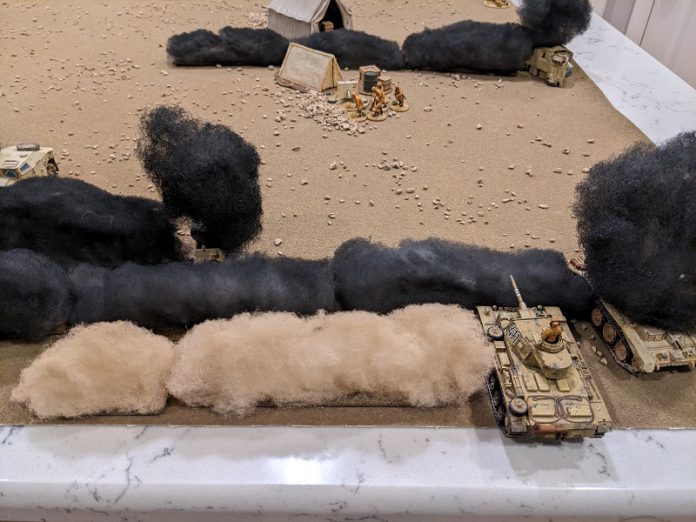


You must be logged in to post a comment.